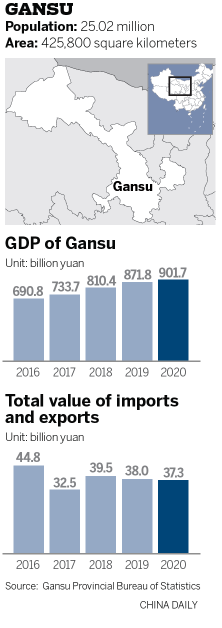After overcoming absolute poverty, North West Province focuses on rural revitalization and modernization of agriculture
Editor’s note: This year, the Chinese Communist Party celebrates the 100th anniversary of its founding. China Daily publishes a series of articles on the tremendous changes that have taken place in provinces, autonomous regions and municipalities under the leadership of the Party. They also include stories of people and places that left indelible marks on the Party’s path to glory.
Gansu Province in northwest China has made great strides in its economic development and social benefits, and provincial authorities have ambitious plans to make it a stronger economy over the next five years.
During the 13th Five-Year Plan period (2016-20), Gansu maintained fairly stable economic growth. Its GDP hit 901.7 billion yuan ($141 billion) last year, up from 655.7 billion in 2015, an average annual increase of 5.5 percent, according to the province’s work report released. at the end of January.
Big changes in the province’s economic and social prospects have taken place since the 18th National Congress of the Communist Party of China in 2012, said Gansu Party leader Yin Hong.
“The province has completely removed its poverty label, with 5.52 million people lifted out of poverty, and their per capita disposable income has grown by 19.8% annually. We have eliminated absolute poverty,” he said.
Gansu has achieved an optimized economy and victory over poverty through government efforts. To help once-poor people enjoy a better quality of life, the province has invested about 83.7 billion yuan over the past five years – with an annual increase of 24.5% – in efforts such as the return of school dropouts to campuses and the renovation of dilapidated houses.
The inhabitants of the village are all covered by the provincial health plan, and nearly 499,000 previously destitute people have been relocated thanks to the government’s financial investment.
Yin said that with all formerly poor rural residents lifted out of poverty, Gansu will focus on rural revitalization and accelerating the modernization of agriculture during the 14th Five-Year Plan period ( 2021-25).
He said one of the province’s long-term goals is to complete its campaign to establish a modern production and management system for agricultural development.
The campaign, launched in April, aims to raise the output value of the province’s agricultural industry to 545.2 billion yuan in 2023 from the current 324 billion yuan, a growth target of 68.3 percent. .
“We will also prioritize stabilizing and increasing rural people’s incomes by helping them get jobs and providing them with political support,” Yin said. “It is vital to provide them with assistance, whether financially or politically, to prevent them from falling back into poverty.”
In addition, rural revitalization is key to the province’s work this year, as it aims to develop efficient, high-quality agricultural industries and help farmers earn a better living, he said.
The province will channel resources to rehabilitate wastelands and alkaline lands. It will turn about 2,300 square kilometers of that land into high-quality farmland this year and produce about 12 billion kilograms of grain, ensuring food security, according to the province’s work report.
Gansu has also made protecting its ecological environment a priority in recent years.
For example, the Qilian Mountains, once damaged by improper mining, have been restored to their beauty thanks to the province’s campaign to improve the environment.
About 144 mines in the mountain reserve have been closed and 25 tourism-related projects have been improved. Additionally, herders and farmers in the central area of the reserve have been relocated to reduce damage from human activities.
Meanwhile, Gansu has lofty aspirations to become a more livable place, with a stronger economy and better social benefits.
The province will focus on high-tech development, rural revitalization and public services this year, the first of the 14th Five-Year Plan period.
It has set itself a GDP growth target of 6.5% this year, as well as a relatively low unemployment rate – around 6% – to ensure a healthy and stable social environment, according to the work report.
To help unlock the province’s economic growth potential, Yin has focused on streamlining administrative procedures, thereby providing a better business environment for the company’s operators.
Yin said the business environment reflects the province’s overall capabilities, which are key to boosting the market.
He said that to build an open business environment, it is important to reduce administrative procedures while strengthening official supervision.
He also demanded the establishment of a mechanism to make official information more accessible to the public, improve people’s lives and facilitate business operations.
As for the long-term development of the 14th Five-Year Plan, it will rely on the production of a batch of high-tech enterprises to make innovation the new engine of the province’s future growth.
For example, it will implement more user-friendly policies to attract talent and produce about 10 other key high-tech enterprises whose total revenue is expected to exceed 5 billion yuan annually over the period.
Some infrastructure construction campaigns involving highways, airways and roads linking rural areas will be carried out. In addition, the province will make green philosophy a priority in its economic development by adding green industries.
Improving social benefits is also vital to the development of the province during the plan period.
“So far, Gansu has entered a new era of building a socialist China, and we will carry out our campaign focusing on high-quality development. We will pay more attention to environmental protection and the systematic management of the province to improve people’s quality of life and make the province a livable and wealthy place,” Yin said.
Contact writers at [email protected]
A view of Lanzhou, capital of Gansu Province, from White Pagoda Mountain Park. Zhongshan Bridge, dubbed the “first bridge over the Yellow River”, is in the middle. MA JIAN/FOR CHINA DAILY

EVERYDAY CHINA



